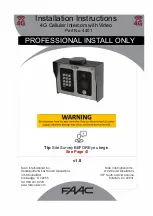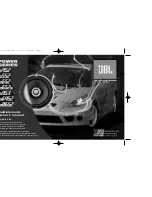
Index to speaker parts
Notes on usage
Do not touch the diaphragm of each speaker unit.
The color and appearance (grain patterns) may vary among the enclosures because
natural wood is used. Depending on lighting conditions, the enclosures may look
different, but this does not indicate damage.
Do not put any object or your hand into either of the ducts (upper or lower) located on
the rear of the enclosure.
If there is a foreign object in the duct, do not attempt to take it out by yourself. Please
consult your nearest dealer.
The spikes are made in screw form. Make sure that the spikes are not loose. If they are
loose, tighten them up by turning each spike clockwise.
*1
Before attaching the grille frame, confirm its correct mounting orientation. When
attaching, press above the pin to firmly secure it. If the grille frame is protruding
outward (it will not come off), push it all the way in. Attaching the grille frames is
recommended even when not using the speakers in order to protect them from damage.
The speakers can be enjoyed with the grille frames attached, but superior performance
can be achieved by removing the grille frames. When removing the grille frame, take
care not to bend or distort its shape excessively.
*2
The lower duct on the rear is located slightly to the right of the center.
Setting the speakers
A
Set the distance between the speakers to less than the distance between the listening
position and each speaker.
B
Place the speakers an equal distance from the listening position.
C
Place the speakers more than 50 cm (20 in) from a wall.
Speaker placement is one of the most important factors in obtaining high-quality sound.
Observe the following when placing your speakers to obtain full advantage of the speaker
characteristics:
Set up the speakers on a hard, flat floor.
Make sure the spikes are not loose.
Place the speakers near a hard wall with their rears more than 50 cm (20 in) away from
the wall.
Place the speakers in similar acoustic environments (i.e., in the same room).
Place the speakers so that the tweeters are at the same height as your ears when you are
seated.
Place the speakers at an equal distance from the listening position.
If you cannot place the speakers wide enough apart, turn the speakers slightly outward.
Likewise, if the speakers must be placed more than 2 meters (80 in) apart, turn them
slightly inward for more effective stereo sound.
Do not place the speakers in the following locations:
In places subject to high temperature or direct sunlight
In places subject to excessive dust and dirt
In places subject to high humidity
Near source components (CD players, record players, etc.)
Near magnetic cards (credit cards, commuter passes, etc.)
Magnetic cards may fail due to the magnets in the speaker units.
Near televisions
The speakers are not magnetically shielded. Therefore, if you use the speakers near CRT-
based televisions, color shading occurs on the television screen.
Amplifier connections
Selecting the amplifier/speaker cords
Select an amplifier (not supplied) and speaker cords (not supplied) meeting the following
requirements.
For selecting an amplifier:
The speaker impedance is designed as 4 ohms. Excessive sound volume may damage the
speakers, so be aware of the position of the volume level knob on the amplifier and avoid
excessive input.
Requirement for selecting speaker cords (one pair)
In order to output high-quality sound signals, use speaker cords of the minimum necessary
length that are treated with either of the following two fittings at their ends:
With cable cores (less than 4.5 mm (
3
/
16
in) in diameter) bared by stripping the jacket to
10 mm (
13
/
32
in) from each + and - end
The bare cable core may become oxidized over time. In this case, reconnect the speaker
cords after stripping the jacket to expose a fresh segment of cable core at each end. This
will ensure that you can enjoy better sound.
With spade plugs (more than 8 mm (
11
/
32
in) in inner diameter, and less than 12 mm
(
1
/
2
in) in outer diameter)
Connecting to the amplifier
Before connecting, turn off the amplifier.
Connect the terminals of the right speaker to the right speaker terminals of the amplifier,
and connect the terminals of the left speaker to the left speaker terminals of the amplifier.
Note
Tighten each binding post securely. Periodically checking the tightness of the binding posts
is recommended to prevent them from becoming loose as time passes.
About aging
The speakers take some time to provide their best performance. Play the speakers at
normal volume for about 10 hours to break them in.
Specifications
Speaker system
3-way 6-driver speaker system, Bass reflex
Speaker unit
Woofer: 165 mm (6.5 in), cone type (2)
Midrange: 130 mm (5.25 in), cone type (1)
Tweeter: Main tweeter, 25 mm (1 in), dome type (1)
Assist tweeter, 19 mm (0.75 in), dome type (2)
Rated impedance
4 ohms
Maximum input power
100 watts
Sensitivity
90 dB (2.83 V, 1 m)
Frequency response
45 Hz - 45,000 Hz
Dimensions (w/h/d)
Approx. 255 × 990 × 415 mm (10
1
/
8
× 39 × 16
3
/
8
in)
Mass
Approx. 32 kg (70 lb 9 oz)
Supplied accessories
Cleaning cloth (1)
Design and specifications are subject to change without notice.
Precautions
Before turning an amplifier or a source component on/off
Set the volume of the amplifier to minimum.
If the bass cannot be heard or the phonic positions of instruments are
indefinite
Make sure to connect the speaker cords by ma/– to the appropriate speaker
terminals.
Cleaning of the enclosure
Do not use any type of neutral detergent, benzene, or alcohol because they may damage
the surface finish of the enclosure.
To maintain the fine gloss of the enclosure for a long time, gently wipe off dust using a
soft brush or feather duster, and then wipe the enclosure with the supplied cleaning cloth.
(Do not use any type of scrub brush or sponge.)
Wipe smudges such as fingerprints or oil spots with the supplied cleaning cloth carefully.
When the smudges are hard to remove, wipe them off with a soft cloth soaked in soapy
water, and wrung dry.
Make sure not to damage the enclosure.
The supplied cleaning cloth is washable and can be used repeatedly.
To avoid damaging the speakers
Do not disassemble or modify the speaker units, network circuits, or the enclosure.
To avoid damaging the circuits
Do not input the following signals continuously:
FM inter-station noise
High-frequency signals of electronic instruments
High output and high-frequency signals in the fast-forward and rewind modes of a tape
recorder
Summary of Contents for SS-NA2ES
Page 8: ...Printed in Japan ...


























